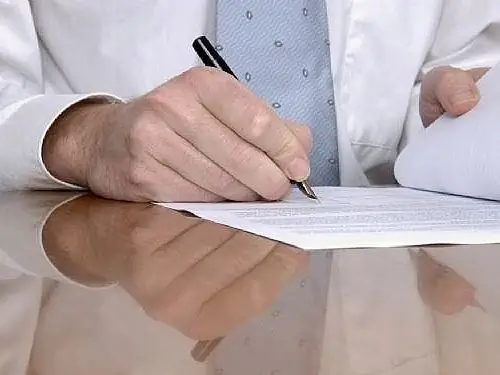- Author Isaiah Gimson [email protected].
- Public 2023-12-17 02:53.
- Last modified 2025-01-24 12:06.
The single tax is paid by individual entrepreneurs and organizations using a simplified taxation system. It can be charged at the rate of 6% from the amount of income or at the rate of 15% from the amount of income reduced by expenses.

Instructions
Step 1
Record tax indicators on an accrual basis throughout the year in the Income and Expense Book. Do not take into account transactions that do not affect the tax base under the simplified tax system.
Step 2
Design the Book as follows: lace and number its pages, indicating their total number on the last page. Put the signature of the head of the organization (individual entrepreneur) and the seal in the document, and then submit it to the tax office for certification.
Step 3
Print sheets of the book on paper at the end of the reporting period if you are maintaining it electronically. At the end of the tax period, number and lace it, indicating the number of pages obtained. Certify it with the signature of the head and the seal, as well as the signature and seal of the tax official.
Step 4
Consider in the Book income from sales and non-operating income on a cash basis. In this case, the date of receipt of income is the day of receipt of money, property or repayment of debt in another way. When the object of taxation is “income”, the taxable base is not reduced by the amount of expenses (except for expenses for temporary disability benefits and insurance premiums). When the object of taxation is “income minus expenses”, only economically justified and documented costs are taken into account.
Step 5
At the end of the tax period, issue a Reference to Section I of the Book if the object of taxation is income minus expenses. Reflect in line 010 income, in line 020 - expenses, in line 030 - the difference between the paid minimum and calculated single taxes for the previous tax period. Enter a positive value for the tax base on line 040 or negative on line 041.
Step 6
Draw up and submit to the tax office a single tax declaration for the 1st quarter, half a year, 9 months on advance payments of the single tax no later than 25 days from the end of the relevant reporting period. The declaration is filled out in rubles (without kopecks).
Step 7
Determine the amount of the minimum tax at the end of the tax period when the object of taxation is income minus expenses. It is 1% of the amount of taxable income. Compare it with the calculated flat tax at the regular rate. You need to pay the amount that turns out to be more.
Step 8
At the end of the year, draw up a revised declaration, which is submitted no later than April 30 of the year following the expired tax period (for organizations - no later than March 31). Subtract from the amount of advances paid for 9 months, the flat tax calculated for the year, as well as the amount of contributions and benefits issued. If there is an overpayment for tax, then line 060 is not filled out in it, and the overpayment is reflected in line 070.
Step 9
Make the payment of the single tax within the same deadlines as set for filing returns for this tax.






